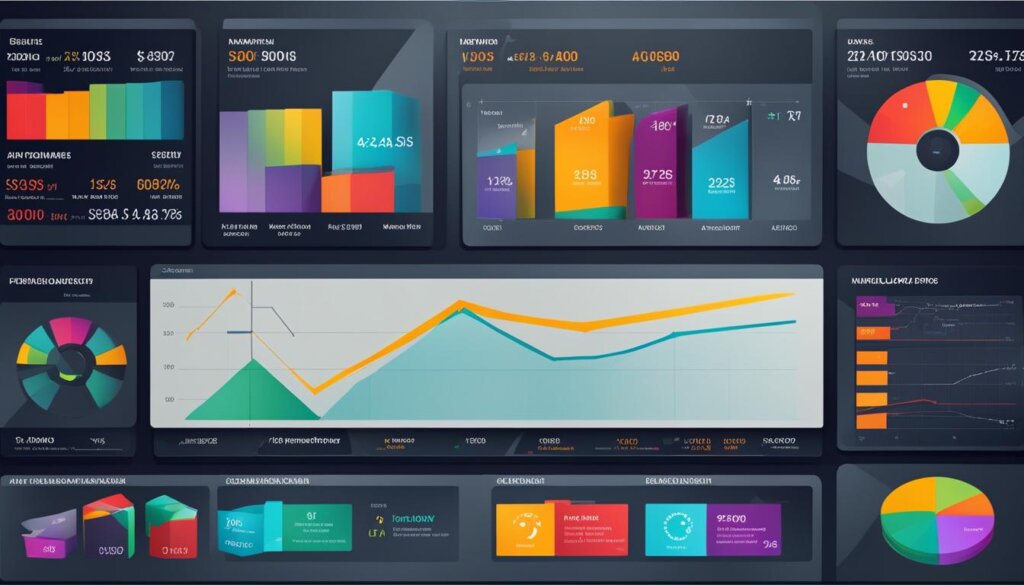Table of Contents
Key Performance Indicators (KPIs) play a critical role in measuring and evaluating a company’s business performance. They provide valuable insights that enable businesses to make informed strategic decisions and drive improvement. KPIs are quantifiable measurements that help track progress towards specific goals and objectives.
In the world of business, KPIs can span various aspects, including financial metrics, customer-focused KPIs, and process-focused KPIs. Financial metrics encompass key indicators such as net profit, revenue, and liquidity ratios, providing a snapshot of the company’s financial health. This information is crucial for making strategic financial decisions and planning for the future.
Customer-focused KPIs allow businesses to gauge customer satisfaction and retention, providing insights into the effectiveness of their products or services. These measurements can include metrics such as customer satisfaction rating and average resolution time, enabling businesses to enhance the customer experience and build long-lasting relationships.
Process-focused KPIs, on the other hand, focus on evaluating operational performance across various functions within the organization. These metrics analyze factors like production efficiency and error rates to identify areas for improvement and optimize overall process performance.
By tracking KPIs through analytics software and reporting tools, businesses gain visibility into their performance data. This data-driven approach enables companies to identify trends, establish benchmarks, and make data-backed decisions to drive business growth. Furthermore, regularly monitoring KPIs ensures accountability and helps businesses remain focused on their goals.
In the upcoming sections of this article, we will delve deeper into the different categories and types of KPIs, as well as the best practices for setting and using them effectively in your business.
Categories of KPIs
KPIs can be categorized into four main types: strategic KPIs, operational KPIs, functional KPIs, and leading/lagging KPIs.
Strategic KPIs provide a high-level snapshot of how a company is performing and are often used by executives to make informed decisions regarding the overall direction and success of the business.
Operational KPIs, on the other hand, focus on monitoring performance over shorter time frames. They are used by managing staff to assess day-to-day operations and ensure that they are running smoothly and efficiently.
Functional KPIs measure performance within specific departments or functions of the organization. They provide insights into specific areas of the business, such as sales, marketing, or HR, allowing for targeted improvements and performance tracking.
Leading/lagging KPIs differentiate between indicators that signal future events (leading) and indicators that measure outcomes based on past performance (lagging). Leading KPIs help organizations anticipate trends and take proactive measures, while lagging KPIs provide a retrospective analysis of past actions and outcomes.
By categorizing KPIs into these distinct groups, businesses can better understand and analyze their performance from various perspectives, enabling them to make informed decisions and take strategic actions to drive success.
Benefits of Categorizing KPIs
“Categorizing KPIs allows businesses to gain a comprehensive understanding of their performance in different areas. It helps identify strengths, weaknesses, and areas for improvement, ultimately leading to more focused and targeted strategies.” – Mark Smith, Business Analyst
Types of KPIs
Key Performance Indicators (KPIs) are essential tools for measuring and evaluating various aspects of a business’s performance. Let’s explore the different types of KPIs that organizations use to assess their financial health, customer experience, process performance, and marketing effectiveness.
1. Financial Metrics
Financial KPIs provide valuable insights into a company’s financial well-being. These metrics help monitor profitability, liquidity, and solvency ratios, among others. Some commonly used financial KPIs include:
| Financial Metrics | Description |
|---|---|
| Liquidity Ratios | Measure a company’s ability to meet short-term obligations. |
| Profitability Ratios | Assess the company’s ability to generate profits. |
| Solvency Ratios | Evaluate the long-term solvency or financial stability of a company. |
| Turnover Ratios | Measure the efficiency of asset utilization. |
2. Customer Experience Metrics
Customer experience metrics provide insights into how well a company serves its customers. These metrics focus on customer satisfaction, retention, and efficiency. Some commonly used customer experience KPIs include:
| Customer Experience Metrics | Description |
|---|---|
| Average Resolution Time | Measures the average time taken to resolve customer issues or requests. |
| Customer Satisfaction Rating | Assesses the level of satisfaction customers have with a company’s products or services. |
3. Process Performance Metrics
Process performance metrics help businesses analyze and optimize their operational efficiency and effectiveness. These metrics measure factors such as productivity, quality, and error rates. Some commonly used process performance KPIs include:
| Process Performance Metrics | Description |
|---|---|
| Production Efficiency | Evaluates the efficiency of the production process in delivering products or services. |
| Error Rate | Measures the frequency of errors or defects in a company’s processes or outputs. |
4. Marketing KPIs
Marketing KPIs help assess the effectiveness and impact of marketing activities. These metrics measure factors such as website traffic, social media engagement, and lead generation. Some commonly used marketing KPIs include:
| Marketing KPIs | Description |
|---|---|
| Website Traffic | Measures the number of visitors to a website. |
| Social Media Engagement | Assesses the level of audience interaction and participation on social media platforms. |

Setting and Using KPIs
Setting Key Performance Indicators (KPIs) is a crucial step in aligning organizational goals and driving outcomes. KPIs help companies define their key objectives, providing a clear roadmap for success. To effectively assess performance, it is vital to identify both lagging and leading indicators.
Lagging indicators evaluate past performance, while leading indicators highlight actions needed to achieve future objectives. By understanding the relationship between the two, businesses can make data-driven decisions and implement strategies to improve performance.
To ensure progress is measurable and actionable, setting targets and thresholds is essential. These benchmarks act as guideposts along the way, enabling organizations to evaluate their progress and make necessary adjustments.
Regularly assessing progress is key to keeping objectives on track. This ongoing evaluation allows businesses to track their performance, identify areas of improvement, and stay focused on their goals.
To utilize KPIs effectively, it is important to follow best practices. Aligning KPIs with business objectives is critical, ensuring that the selected indicators are relevant and contribute to overall success. Additionally, it is essential to choose a manageable number of specific indicators to avoid overwhelming data overload.
By implementing KPI best practices, businesses can effectively monitor their performance, make data-driven decisions, and continuously improve. With a strong framework in place, organizations can achieve their key objectives and drive success.
FAQ
What is a KPI in business?
Key Performance Indicators (KPIs) are quantifiable measurements used to evaluate a company’s long-term performance. They help businesses track their progress and make informed strategic decisions.
How are KPIs categorized?
KPIs can be categorized into four main types: strategic, operational, functional, and leading/lagging KPIs.
What are the types of KPIs?
The types of KPIs include financial metrics, customer experience metrics, process performance metrics, and marketing KPIs.
How do you set and use KPIs?
Setting and using KPIs involves defining key objectives, identifying lagging and leading indicators, setting targets and thresholds, assessing progress regularly, and following best practices.







